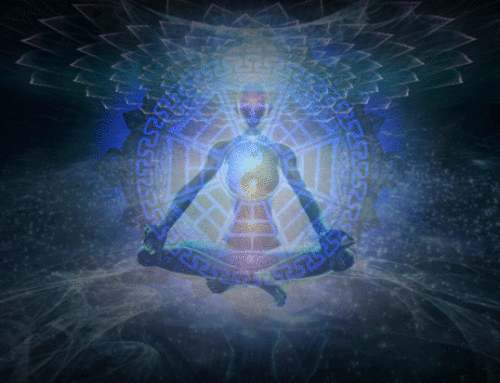“All creation – gods, demons, universes – is the expansion of the Creator’s thought into form. The nucleus of this is the substance of his mind. The power of projection is his will.”
That portion of Tantrism presented in the foregoing articles constitutes a methodology capable of universal application. There is, however, another aspect of the system that for most Western students must remain strangely exotic and almost wholly within the realm of theory. That is the considerable part of Tantra which deals with siddhi or magical powers.
The main body of this secret knowledge is contained in such texts as the Indrajala Tantra or in the Damaras; in manuscripts buried deep within lamasary librarie in Tibet; and in oral traditions, transmitted only by word of mouth from guru to shishya.
Dangerous Rituals And Techniques
Most of the disciplines contain rituals and techniques far too dangerous to be presented in detail in a popular work such as the present one. This does not preclude, however, the discussion, in a broad sense, of their nature and underlying principles. Also, one or two typical disciplines that can be safely practiced by Western students, may serve to stimulate further interest and research.
The Christian And The Tantrik
There is, in fact, an urgent need for Western man to reexamine the whole concept of the supernatural in religious belief. A careful and honest evaluation of his faith may reveal to him that its mystical foundations are no longer tenable for him. At best, he will have to admit that he does not know where to draw the line between the credible and the incredible.
It is one of the illusions of the contemporary Western mind that Christianity will find a new lease on life if only its scriptures can be “demythologized.” Actually, such efforts at modernizing are, in the final analysis, merely admissions of pyrrhonist.
This growing and widespread disbelief is nowhere more evident than in the present-day skepticism among Christians concerning the miracles performed by Jesus and recounted in the New Testament.
How, for example, does the contemporary churchman explain the incident related in the Gospel of Matthew (XXI: 19)?:
“And when he saw a fig tree in the way, he came to it and found nothing thereon, but leaves only, and said unto it, Let no fruit grow on thee henceforward forever. And presently the fig tree withered away.”
Outside a Fundamentalist minority, most Christians either avoid stating an opinion, or, admitting that the Biblical record runs counter to scientific knowledge today, call for a new interpretation “to make the Gospel relevant to contemporary life.”
The new interpretation does not, as did Tertullian, avail itself of the paradox. Tertullian declared:
“I believe because it is absurd .. . It is certain because it is impossible.”
However, it is not within the nature of the modern, Western personality to acknowledge anything as “real” which exists beyond the reach of reason, or outside the domain of physical law.
Accordingly, when confronted with stories of such irrational events as a crowd of five thousand being fed with five loaves and two fishes; or Lazarus raised from the dead, the educated Christian is obliged to adopt one of the following points of view:
1) The occurrence as described in the Biblical narrative did not really happen. The scriptural account is merely a legend, told to lend importance to the life and ministry of Jesus.
2) The “miracles” are really exaggerated accounts of natural happenings. E.g., Lazarus was not dead in the literal sense, but was mistaken for dead by his friends and relatives, while actually in a cataleptic state of suspended animation.
3) The stories of seemingly supernatural phenomena are really allegories used in exposition of spiritual truths. Hence, the story of Lazarus illustrates man’s symbolical death, until he hears the voice of Jesus summoning him from the tomb of his sinful past. For did not Jesus himself elsewhere say, “. . . ye are like unto whited sepulchers, which indeed appear beautiful outward, but are within full of dead men’s bones, and of all uncleanliness.”
The Christian rationalist who believes that he has thus bridged the hiatus between Biblical record and scientific report, has in fact stopped short of the ultimate conclusions inherent in such a position.
For, carried to its logical extreme, rejection of the so-called miraculous element in religion becomes a rejection of religion itself, at least as religion is exemplified in the acts and utterances of Jesus of Nazareth.
What remains may be a noble way of life, but it is an ethic, not a revealed faith. Sooner or later, the Christian who is honest with himself will have to reject more than merely the wonderful deeds called miracles in his sacred texts.
To be consistent, he will also have to expel from his canon such familiar and fundamental practices as prayer. For is not prayer, in its commonly accepted sense, addressed to God, saints or intercessors – all supernatural entities?
Every supplication (including the oft-recited Lord’s Prayer) is magical in that it seeks to influence the “scientific” principles of cause and effect by asking divine intervention in human affairs.
On the secular, legal level, extirpation of the miraculous in our national life was achieved by the recent U.S. Supreme Court ruling that bans prayer in public schools.
Litigants, both individuals and groups, who successfully petitioned for this relief, were not motivated by fear of an established religion, or by desire for separation of church and state.
The secret and true dynamic of their action was the resolute determination to uproot from contemporary society the last vestiges of the supernatural.
The Tantrik And Miracles
Viewed from a standpoint of calm detachment, the Western “believer” is thus a tragic and somewhat absurd figure, whose feverish involvement in social issues hides a poignant longing for a faith more spiritually fulfilling.
It is ironical that the non-Christian Tantrik would find no difficulty in accepting the miracle stories of the New Testament in their most literal sense. One reason for this is the fact that he would not view them as miraculous in the same way that the Christian would. That is to say, the Tantrik would see them as natural events, produced by expert use of little-known forces. These forces, like everything in the universe, are but various manifestations of cosmic mind-stuff.
Shaktas believe that the ability to produce so-called psychic phenomena by means of this energy can be acquired by anyone who is willing to undergo the long and extremely arduous training necessary. Jesus, in fact, made it clear that the “wonders” accomplished by him, could be duplicated by his disciples.
As the Tantrik conceives it, mind is the noumenal source of all phenomena. All aspects of creation, both visible and invisible are – regardless how tangible and objective they may seem to be in the physical world-only thought images projected by God or by other entities.
Psycho-Mental Energy
According to the secret lore, man can develop such concentration of mind that he is able to generate psychomental energy (called rtsal in Tibet) and to use it for bringing about results that to the unitiated appear to be supernatural.
It is because the Tantrik techniques employ these secret methods of concentration that Tantrism has been called the most elaborate system of auto-suggestion in the world.
While such an evaluation may serve to explain the more subjective visions of the sadhaka, it is hardly adequate to account for phenomena witnessed by persons other than the creator of them.
For example, Tantrik adepts (especially in Tibet) possess methods for projecting thought forms (called tulpas) which are materialized so completely that they are often mistaken for physical entities.
Moreover, these phantoms are sometimes vitalized and given a kind of autonomy, so that they may act and seemingly think without the consent or even the knowledge of their creator.
In this connexion, Madame Alexandra David-Neel, a Frenchwoman who spent many years among the lamas of Tibet, recounts an intriguing personal experience in creation of a tulpa.
Having a skeptical turn of mind, Madame David-Neel suspected that many stories she had heard concerning such materializations might be gross exaggerations.
The most common kind of tulpa-making in Tibet is that of forming and animating the counterparts of Tibetan deities. So, to avoid coming under the influence of this kind of mental suggestion – so prevalent around her – she chose for her thought child the figure of a fat, jolly monk.
After a few months of performing the prescribed disciplines for ritual projection of a thought image, Madame David-Neel relates that the form and character of her phantom monk took on the appearance of real life. He shared her apartment like a guest and when she departed for a journey, he accompanied her entourage.
At first, the monk put in an appearance only when his creator thought of him. But after a time, he began to behave in a very independent manner and to perform various actions not directed by his maker.
So real did he become in time, that on one occasion, when a herdsman came to the Frenchwoman’s encampment to bring her some butter, he mistook the chimerical monk for a live lama.
Even more alarming to the phantom’s begetter, his character began to undergo a subtle change. He grew leaner and his face gradually took on a sly, malevolent look. He daily grew more importunate and bold.
“In brief,” says Madame David-Neel, “he escaped my control.”
Clearly, the time had come to purge herself of the unwanted companion whom she had brought to life, but who, by her own admission, had turned her existence into a day-nightmare.
It required six months of difficult practice and ritual to magically dissolve the monstrous prodigy.
“My mind-creature was tenacious of life,” she declared.
How are we to explain such phenomena? Western psychology has only begun to investigate the secret and profound life of the mind. Many of their answers so far are far from adequate to account for occurrences such as that just cited.
The theory of hypnagogic hallucination is not satisfactory, since the image is clearly perceived by another person not aware of its existence.
Nor is the eidetic image explanation, which serves to clarify cases of children who have imaginary playmates that, for them, are real. Such invisible companions appear to be wholly subjective, although the annals of psychic research contain accounts of some in which adults have also seen the phantom playmate.
Be that as it may, in the case of the deliberately created phantom, such as Madame David-Neel’s monk, the independence and individuality of the prodigy ought to give us considerable pause.
Even in the West, there have been instances in which thought images projected by one person, have been perceived and described by another who was totally unaware of the kind of mental picture projected.
An experiment of the kind was tried in France some time ago, with a satisfactory measure of success.
A person possessed of extraordinary powers of concentration was seated in a room opposite a plain white wall. He was asked to focus his attention upon the wall and to try to project upon it a certain mental image.
After a period of intense concentration, he left the room. A “sensitive” – that is, a person with highly developed faculty of extra-sensory perception – was then brought in.
The latter was instructed to concentrate upon the blank wall and to see whether he could detect the thought image projected upon it by his predecessor.
According to a published account of the experiment, the psychic clearly perceived and described phantom images upon the wall. It corresponded with that envisioned by the projector.
Tantrik texts assert that the universe all about us is teeming with thought forms and with beings good and bad – deities, demons, nature spirits, discarnate human egos, phantoms, monsters.
The sadhaka is not only made aware that they exist; he is taught disciplines that bring them under his con-trol and enable him to communicate freely with them.
“Lady Cloud Walkers”
In Tibet, where rites aimed at this end (called dubtobs) still hold an important place in yogic practices, monks of several schools claim initiation by performance of the sex ritual with a female deity or Dakini. They aver that maithuna with a goddess of this kind results in bliss much more satisfying than that experienced when a mortal woman is the consort.
These Dakinis, who are also known as Khadomas or “lady cloud walkers,” are the Tibetan equivalent of the Hindu yakshis. They are said to bestow great benefits upon the yogi who knows how and when to unite with them.
Indo-Tibetan texts devote considerable space to their praise and to descriptions of their beauty and grace of form. They are depicted as having finely-textured, ruby red skin; gentle, pensive faces; red eyes and finger nails; and are said to exude the faint fragrance of lotus blossoms.
On the walls of all Tantrik Tibetan temples will be found paintings (thankas) showing the Dakinis in both their benevolent and their wrathful aspects. In the latter form, they are sometimes portrayed as ferocious tiger-woman vampires, who feed on the flesh and blood of human victims. Others are naked, except for a ritual green scarf (kata) around their necks.
In a lower category of unearthly entities are nymphlike fairies, “white as lotus flowers, with pink eyes, and who are addicted to white, perfumed garments.”
Tibetans believe these fairies sometimes incarnate as women. Consequently, they are much sought-after as ritual partners in lata-sadhana. The secret doctrine lists several special signs (physical characteristics) by which they may be identified.
“She-Devils”
Other incarnating forces of Shakti take the forms of lhamos (she-devils), sorceresses, and bhutas (evil spirits).
It has been reported that some of the less enlightened “brothers of the hidden life” practice sex union with these she-devils; with discarnate human beings; and with phantoms whom they materialize for the purpose. Such practices are emphatically condemned by almost all gurus as being the lowest form of black magic.
Moreover, consorting with the latter class of entities is not without its dangers. Tantrik literature contains many warnings to the novice concerning the perils inherent in such intercourse. He is admonished that if these fiends escape his control, they may do him great harm, both physically and spiritually. Many Tibetan magicians construct thread-traps and magic cabinets to imprison them.
Four Magical Powers
And despite all warnings, Tibetans do not consider that a yogi has won his mystic spurs, so to speak, until he has pitted his thaumaturgic skill against that of various demons, and has acquired at least the classical siddhis or magical powers. These are:
- Shiwa – the power to prevent misfortunes befalling oneself or others. It also includes the power of guarding against illness, and of prolonging the life-span.
- Gyaispa – the so-called Expanding Yoga, by which power is attained to secure prosperity, fame, progeny and knowledge.
- Bangwa – the Yoga of Ascendancy, by which the sadhaka controls assisting forces to influence man, animals, and inanimate objects. It also provides the means of attracting whatever one desires.
- Dragpo – the Wrathful of Banishing Performance, the most terrible of all powers. By its disciplines, the yogi possesses the power to cause calamities, create enmity between human beings, kill and destroy; strike a person speechless, etc.
It is the dragpo techniques that are employed by the black magicians of Tibet who, unlike other Buddhists, believe in taking life and causing pain. Like their counterparts in the West – the Satanists – who employ an inverted crucifix and recite sacred liturgies backward, they intone the celebrated Tibetan mantra, “Om mani padme hum” in reverse.
Other siddhi or miraculous powers claimed by Tibetan mystics, as well as by a few Tantriks of India, include such things as: the ability to become invisible in a crowd; to walk upon water or through the air; to enter fire with immunity from burn; to walk long distances at incredible speed (called lung-gom); to know the thoughts of others; to yogically induce such great heat within the body that it will melt a snowfield; and to pass through walls or solid objects.
Two additional siddhi that are considered especially important in Tibet and deserve mention here, are those called pho-wa and throng-jug.
Briefly, pho-wa or the Yoga of Transference, is the mystic art of simulating the natural death process with-out fully and permanently cutting free from the body. That is to say, the yogi projects his consciousness or subtle body through the so-called Brahmananda (an aperture in the crown of the head), and travels about freely upon other planes of consciousness. It is a process similar to that known in the West as projection of the astral body.
An American neurologist, Dr. Andrija Puharich, who is conducting a remarkable program of scientific re-search in this and related fields, refers to the projected self as the “nuclear mobile center of consciousness.” He relates the story of a prominent New York radio producer who experienced the pho-wa state when he accidentally inhaled some glue he was using in the construction of a cabinet in his children’s room.
In the case of Pho-wa, however, the out-of-body consciousness is not left to wander indiscriminately, but is strictly disciplined and set to accomplishing definite objectives.
One of the latter is to assist dying persons with a kind of spiritual guidance that directs their entrance into the Bardo plane – the state intermediate between death and rebirth. Details of this discipline have been discussed at length in several books available to the general public. The most authoritative and complete of these is “The Tibetan Book of the Dead,” an English translation of which has been arranged and edited by the well-known Oxford scholar, W. Y. Evans-Wentz.
Thron-jug involves some of the same procedure as that of Pho-wa, but is more difficult and requires greater advancement on the part of the yogi who performs it.
Essentially, thron-jug is the projection of one’s consciousness into, and the taking over of, another human body. Adepts who claim that power, assert that by means of it they can temporarily discard their own body and take over the body of another person – either one who has just died, one asleep, or even a casual passerby.
There are many stories told in both India and Tibet of various feats of thron-jug, performed by great initiates of the past, such as Shankara in India and Marpa in Tibet. Just how factual these accounts are must be a matter left to the individual judgment of each person who hears them.
As for the practice of pho-wa and thron-jug, all gurus are in agreement upon one point: it is a highly dangerous operation. By repeatedly projecting oneself outside the body, they warn, the yogi gradually loosens the bonds holding him to his fleshly abode. These may eventually be dissolved altogether and the performer find himself without a physical body.
There are other hazards, too. While one is absent from his body, the subtle link still connecting the nu-clear self to the physical form, may be broken, in which case ordinary death occurs.
Also, there is the outside chance that powerful discarnate entities, human or demoniac, may forcibly enter and possess the vacated body. In many cases of insanity, according to the Tibetan theory, such possession has occurred.
For these, and other reasons, Tantrik gurus include the secret art of pho-wa and thron-jug among those teachings called tam-gyud, which constitute the “whispered tradition,” – instruction that is always transmitted orally from teacher to disciple.
Although a number of Tantrik teachings are thus considered too dangerous to be committed to the written or printed word, others have been preserved in manuscript form. These manuscripts and Tibetan block prints have been copied many times, often with annotations or commentary added.
To give the reader some idea of the power and purpose of practices contained in this secret lore, the following exercise will be useful. It is performed for the purpose of materializing in the physical plane, anything strongly desired.
Fifth Discipline
The sadhana may be practiced at any time, day or night. However, most gurus say it is more effective when performed before sunrise, in the early morning hours.
Either Eastern or Western posture may be used, so long as the spine is kept arrow-straight. The yogi faces the East. If the cross-legged asana of India is assumed, the sadhaka ought to sit on a folded blanket or some kind of padding.
To prepare for the dynamic part of the exercise, he breathes in and out rhythmically to the 7:1:7:1 count employed in early disciplines.
After completing twelve cycles of this ratio (or more, if needed to clear the passages), the postulant relaxes for a moment and allows the breath to flow as it will.
He then grasps the left wrist and upper portion of the back of the left hand with his right hand. With the hands joined in this way, he places them palms downward over the Navel Chakra or transformation center, at the solar plexus.
As explained elsewhere, Tantriks attach great importance to this chakra. It is regarded as a kind of psychic power plant, in which is generated the mystic fire that Tibetans call tumo.
The sadhaka now closes his eyes and visualizes within this center a tiny, intensely brilliant tongue of flame. It should be imagined as being no larger than a hair-thin, incandescent wire, twisted at the top like a corkscrew.
When this image has become clearly established in the mind’s eye, the yogi begins once more to breathe slowly and deeply, using again the 7:1:7:1 rhythm.
As the breath flows in and out, he thinks of his lungs as a bellows, stoking the glowing tongue of fire within the Navel Chakra until it incandesces more and more.
After a time, a soft warmth will envelop the region of the solar plexus. At that point, the yogi substitutes for his image of the tumo fire, a mental picture of the thing or condition desired by him.
Then, by breathing in and out in short, staccato spurts, he causes his abdomen and diaphragm to move back and forth in quick, spasmodic motion, as one does when sobbing. Meanwhile, the desired visualization is continued.
This portion of the exercise lasts for perhaps two minutes during which the sadhaka concentrates intensely upon the desired objective. Then he lowers his head until his chin presses firmly against his chest. All the air is expelled from the lungs, and the breath is held outside for a count of seven. His hands (still clasped in the mudra described above) press the solar plexus and shake that area with a quick, vibrating motion, such as would be produced by an electric reducing belt.
While doing this, he again strongly visualizes his desire, bringing it into sharp focus within his mind.
“Having thus awakened the spirit essence of his desire within himself,” says one text, “the yogi once again inhales. As he does so, he raises his head upward, until he is gazing at the ceiling or sky.”
Then, tensing the muscles of his throat to lock the breath (prana) within, he forces the air quickly down-ward until it presses hard against the diaphragm and the navel chakra.
Holding the breath for a count of seven, the yogi visualizes the tumo flame entering the central canal of his spine (the shushumna) and passing upward toward the crown of the head. With it, he sends the mental substance of his desire.
As he exhales, he imagines his desire to be outside himself. It has now become an exteriorized, living thought form, objective and real.
The first time the discipline is practiced, the sadhaka usually does not repeat it more than three times. But on successive occasions, as he strengthens his desire-image, he may perform as many as seven cycles.
He persists in the practice until the desired objective is fully realized, even if the effort requires many months or years. One of the chief virtues of the Tantrik is perseverance, and constancy in the performance of any given discipline.
“One of the chief obstacles in the path of Western students,” said Pundit Chatterjee, “is their impatience. They are so accustomed to a push-button society in which effect follows cause with lightning speed, they expect instant results from their sadhana.
“But in the Shiva science we have to do with another order of existence – that of the inner planes, where time as we know it does not exist. An event may happen instantaneously, in a year, or in a kalpa. Or simultaneously in all these.
“Therefore, sadhana – if performed rightly and persistently – will surely bear fruit in its proper season and according to divine plan, not man’s.
“If I say to an Indian shishya, ‘Repeat this mantram a crore (100,000) of times,’ he sets himself to the task without complaint. But if I tell a Western student that to be successful in an undertaking, he must recite a single syllable a thousand times, he looks upon it as a great burden.”
A Tibetan lama recently made an observation similar to that of Pundit Chatterjee concerning the time lapse which often ensues between the setting in motion of psychic forces and visible results.
He had been asked by a Western newsman why, if Tibetan naljorpas (wizards) possess the supernatural powers they claim, they permitted the Chinese Communists to occupy their country and to drive the Dalai Lama into exile.
“The chronicle is not yet closed,” he replied. “We have released an invisible army of the dharmapalas (guardian demons) against our foe. Terrible suffering and defeat will yet come to the invader – those who pollute the pure Land of Snows (Tibet), and those who support the godless government in Peking.”
Even as the yogi is acquiring and using the forces of creation, however, he is called upon to meditate constantly upon the unreality of their nature.
The Buddhist tradition, especially, reminds him that he as he appears in this world, and all he creates here, are aggregates of individual elements and, as such, doomed to dissolution in time.
There is nothing that he can hold forever as his own, nothing he can create that will not change and vanish. Dream and dreamer are devoid of enduring substance and true entity. His occult powers (siddhi) are but magic mirrors in which are reflected fleeting images -as the moon in water, a cloud in the sky, a rainbow across heaven – vivid and beautiful, but having no self-substance. For the end of all this is the Great Silence, the unfathomable womb of Shakti.
Call Or Text Me On Tel. +79161559460
Tantra Massage, Tantra Rituals And Techniques in Moscow
Searching For Tantra Massage, Tantra Rituals And Techniques in Moscow Click The Link






